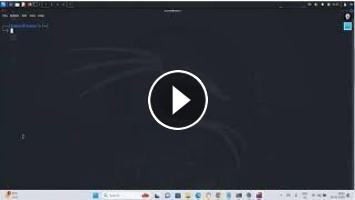Accessing a **shell prompt** and issuing commands with correct syntax is fundamental to working with Linux (and other Unix-like systems). The **shell** acts as an interface between the user and the operating system, allowing you to interact with your system via text-based commands.
### **1. Accessing a Shell Prompt:**
To access the shell prompt (also called the **terminal**), you can:
- **On a local machine**: Open a terminal emulator. On most Linux systems, this is often called "Terminal" or "Console" and can be found in the applications menu.
- **In a virtual machine (VM)**: If you're running Linux on a VM (e.g., Kali Linux, RHEL), just start the VM and open the terminal from the desktop environment.
- **Remote access via SSH**: If you're accessing a remote Linux server, you can use **SSH (Secure Shell)** to connect to the machine. For example:
```bash
ssh username@remote_ip_address
```
This will prompt you for a password to access the system remotely.
Once logged in, you'll be at the **shell prompt**, which usually looks something like:
```bash
user@hostname:~$
```
- `user` is the current user’s name.
- `hostname` is the name of the machine.
- `~` refers to the current user’s home directory.
### **2. Issuing Commands with Correct Syntax:**
Linux commands typically follow this general syntax:
```bash
command [options] [arguments]
```
- **command**: The name of the program or command you want to execute (e.g., `ls`, `cd`, `mkdir`).
- **options**: Optional flags that modify the behavior of the command (e.g., `-l` for long listing with `ls`).
- **arguments**: Files or directories on which the command operates (e.g., a directory path or filename).
### **Example Commands:**
1. **Listing files:**
```bash
ls -l /home/user
```
- `ls`: Lists files.
- `-l`: Option to show detailed information.
- `/home/user`: Directory where you want to list the files.
2. **Changing directories:**
```bash
cd /var/log
```
- `cd`: Command to change directories.
- `/var/log`: Directory to navigate to.
3. **Creating a directory:**
```bash
mkdir new_folder
```
- `mkdir`: Command to create a new directory.
- `new_folder`: The name of the new directory.
4. **Viewing the contents of a file:**
```bash
cat filename.txt
```
- `cat`: Command to view the content of a file.
- `filename.txt`: The file you want to display.
5. **Searching for a file:**
```bash
find / -name "myfile.txt"
```
- `find`: Command to search for files.
- `/`: Starting directory (root directory here).
- `-name "myfile.txt"`: Option to search for a file by name.
### **3. Common Shell Prompts and Syntax Rules:**
- **Case Sensitivity**: Linux commands and file names are **case-sensitive**. For example, `myfile.txt` is different from `MyFile.txt`.
- **Pipes (`|`)**: You can chain commands together using a pipe. The output of one command becomes the input for another.
```bash
ls -l | grep "txt"
```
This command lists all files and then filters the output for files containing "txt".
- **Redirection `)**: Redirect command output to a file.
- `` will overwrite the file.
- `` will append to the file.
```bash
echo "Hello World" file.txt
```
### **Conclusion:**
The shell is an essential tool for managing and interacting with Linux systems. By accessing the shell prompt and using the correct command syntax, you can perform tasks ranging from simple file management to complex system administration. Always be mindful of command syntax, as incorrect commands or options can lead to errors or unintended actions.
### **1. Accessing a Shell Prompt:**
To access the shell prompt (also called the **terminal**), you can:
- **On a local machine**: Open a terminal emulator. On most Linux systems, this is often called "Terminal" or "Console" and can be found in the applications menu.
- **In a virtual machine (VM)**: If you're running Linux on a VM (e.g., Kali Linux, RHEL), just start the VM and open the terminal from the desktop environment.
- **Remote access via SSH**: If you're accessing a remote Linux server, you can use **SSH (Secure Shell)** to connect to the machine. For example:
```bash
ssh username@remote_ip_address
```
This will prompt you for a password to access the system remotely.
Once logged in, you'll be at the **shell prompt**, which usually looks something like:
```bash
user@hostname:~$
```
- `user` is the current user’s name.
- `hostname` is the name of the machine.
- `~` refers to the current user’s home directory.
### **2. Issuing Commands with Correct Syntax:**
Linux commands typically follow this general syntax:
```bash
command [options] [arguments]
```
- **command**: The name of the program or command you want to execute (e.g., `ls`, `cd`, `mkdir`).
- **options**: Optional flags that modify the behavior of the command (e.g., `-l` for long listing with `ls`).
- **arguments**: Files or directories on which the command operates (e.g., a directory path or filename).
### **Example Commands:**
1. **Listing files:**
```bash
ls -l /home/user
```
- `ls`: Lists files.
- `-l`: Option to show detailed information.
- `/home/user`: Directory where you want to list the files.
2. **Changing directories:**
```bash
cd /var/log
```
- `cd`: Command to change directories.
- `/var/log`: Directory to navigate to.
3. **Creating a directory:**
```bash
mkdir new_folder
```
- `mkdir`: Command to create a new directory.
- `new_folder`: The name of the new directory.
4. **Viewing the contents of a file:**
```bash
cat filename.txt
```
- `cat`: Command to view the content of a file.
- `filename.txt`: The file you want to display.
5. **Searching for a file:**
```bash
find / -name "myfile.txt"
```
- `find`: Command to search for files.
- `/`: Starting directory (root directory here).
- `-name "myfile.txt"`: Option to search for a file by name.
### **3. Common Shell Prompts and Syntax Rules:**
- **Case Sensitivity**: Linux commands and file names are **case-sensitive**. For example, `myfile.txt` is different from `MyFile.txt`.
- **Pipes (`|`)**: You can chain commands together using a pipe. The output of one command becomes the input for another.
```bash
ls -l | grep "txt"
```
This command lists all files and then filters the output for files containing "txt".
- **Redirection `)**: Redirect command output to a file.
- `` will overwrite the file.
- `` will append to the file.
```bash
echo "Hello World" file.txt
```
### **Conclusion:**
The shell is an essential tool for managing and interacting with Linux systems. By accessing the shell prompt and using the correct command syntax, you can perform tasks ranging from simple file management to complex system administration. Always be mindful of command syntax, as incorrect commands or options can lead to errors or unintended actions.
- Catégories
- prompts ia














Commentaires